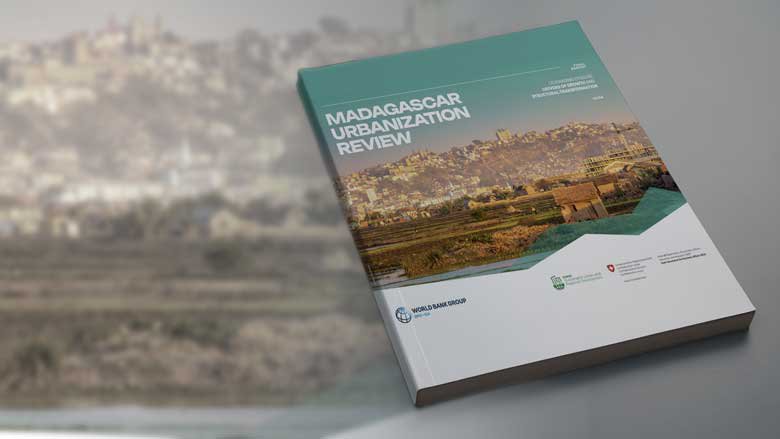Enabling cities in Madagascar to become drivers of economic growth and poverty reduction
Madagascar's cities are the powerhouse of its economy, contributing three-quarters of the national GDP, with the capital, Antananarivo, alone accounting for 44%. Yet, this urban economic might is not translating into effective poverty reduction or inclusive growth. Despite having a faster rate of urbanization than other countries in sub-Saharan Africa, the country has a lower GDP per capita than those countries. Value-added in the services sector – which is one of the main economic activities in cities - has been stagnant since 1990 as a share of GDP. Most alarmingly, poverty in Malagasy cities has increased substantially in the past decade, especially in secondary cities where the share of people living in poverty increased from 46% to 61%. These trends are worrying because more than half the country’s population is expected to live in cities by 2036.
A new World Bank report, Leveraging Cities as Drivers of Growth and Structural Transformation highlights the challenges and constraints facing Madagascar's cities and proposes a roadmap of priority actions that the country can take to stimulate growth and help reduce poverty in the country.
What are the various interlinked factors that hinder productive urbanization in Madagascar?
Rapid urbanization in the country is occurring without sufficient planning, financing, and coordination to accommodate the rising demand for quality jobs, housing, and basic infrastructure and services in cities, resulting in acute service delivery challenges and high levels of informality in jobs and housing. As cities have grown, infrastructure has fallen behind increasing needs. For example, over 60% of urban citizens live in informal and unplanned settlements with a dearth of basic services, often located in hazard-prone and high-risk areas. Less than 20% of people living in medium and small cities have access to direct drinking water supply. Over half the solid waste generated in cities is dumped in drainage canals, causing public health hazards and severe flooding by clogging and overwhelming drainage systems in the city.
The situation is made worse by the increasing frequency of natural disasters and impacts of climate change. Malagasy cities face multiple hazards including floods, cyclones, sea level rise and coastal erosion, that lead to economic and physical losses and can result in the reversal of developmental gains. The number of disaster-related events impacting the country has tripled over the last 20 years. In a business-as-usual scenario that does not promote climate-resilient development in cities, economic losses and the vulnerability of the urban poor will increase with recurring natural disasters driven by climate change.
Cities also have limited fiscal resources, weak mandates, and capacity to deliver services. Fiscal transfers from the central government account for less than one-tenth of cities’ revenues while own-source revenue collection such as property tax is also well below potential, with the result that cities spend less than one-tenth of their budgets on capital investments.
How to better tap into the urbanization potential in Madagascar?
Without urgent action, Malagasy cities will continue to grow informally with negative economic, environmental, and social outcomes. The report proposes four pillars of intervention for tapping the urbanization potential in the country:
- Strengthening the national urban development policy and strategy by having an integrated approach for interventions at the national, regional, and municipal levels: The country needs a strategic focus on transforming its cities, which sets the "rules of the game” for all stakeholders and provides cities with a clear mandate, implementation tools, fiscal resources, and capacity to manage urbanization. This will involve promoting the development of a productive ‘system of cities’ across the country, where every city – large, medium, and small – has a role in improving economic productivity and quality of life based on their comparative advantage. This way, development in other cities will create jobs in a spatially equitable manner across the country.
- Implementing a coordinated policy framework at the national level to improve municipal services and land use planning: The government needs to undertake a set of coordinated policy reforms at the national level to improve fiscal, environmental, and social sustainability of cities and encourage local economic development. Reforms will be needed in areas of urban land administration – building on the successes of the government’s rural land administration reform program, affordable housing, municipal services such as public transport, water and sanitation and municipal solid waste management, climate- and disaster-risk resilience through risk-informed urban development, and increased decentralization of functions and resources to city governments (urban communes).
- Increasing investments and financing for resilient urban infrastructure and services: There is also an urgent need to invest in priority infrastructure and services in cities and to improve their fiscal base to support these investments in the future. The government should avail funding – either directly or through fiscal transfers to cities - to finance priority infrastructure to address gaps in municipal service delivery and increase resilience to climate-induced natural hazards. The resource base of cities can also be improved to finance these needs, with large cities having a strong underlying economic base to support higher own-source revenue collection.
- Improving institutional performance and capacity of cities: Finally, and in parallel to interventions in other pillars, there is a need to set the institutional basis for stronger management of cities by improving their institutional performance and capacity and developing reliable data and reporting systems on urban development.
